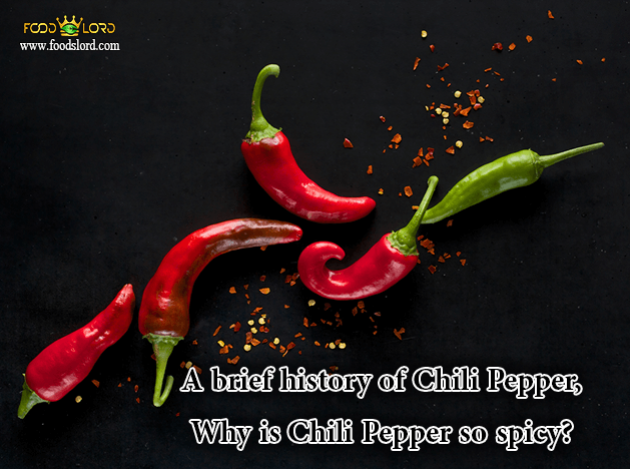In this article we will talk about the history of Chili Pepper and its types. Chili Peppers is native to Central America, especially Mexico, and it has particular importance in tropical Asian and Central American cuisines. Traces of pepper fruit have been found in the prehistoric remains of Peru and Mexico, and these plants have been widely grown in various civilizations in Central and South America. The first peppercorns were transported to Spain in 1493 and from there quickly spread throughout Europe and the rest of the world.
History of Chili Pepper and different types
Chili peppers have been part of the human diet since about 7500 BC and is one of the oldest crops grown in the Americas, as the roots of hot pepper cultivation have been traced to about 6,000 years ago in central-eastern Mexico. They were one of the first crops to be pollinated in Mexico, Central America, and parts of South America.
Christopher Columbus was one of the first Europeans to encounter spicy chili pepper on his first voyage to the Caribbean in 1492, and was dubbed “red pepper” because of its similarity (though not in appearance) to black peppers.
Chili pepper grew in the gardens of Spanish and Portuguese monasteries as soon as it arrived in Europe. It was the monks who first tested the culinary potential of chili pepper and found that their spiciness replaced the black pepper seeds, which were very expensive at the time and used as legal tender in some countries.
Food Lord dried chili pepper is a spicy and delicious seasoning and flavoring for using in a variety of foods and stews.

Why is chili pepper so spicy?
Chemical compounds called capsaicins, odorless and tasteless substances are hidden in white meat inside the pepper. When you eat hot peppers, the chemical binds to receptors that respond to heat-induced pain in the mouth and throat. The brain receives this message and begins to work to remove the hot substance, which leads to increased blood circulation (increased metabolism), cooling sweats, and normal reactions to any stimulus (runny nose and tears). Be. This pain also leads to the release of endorphins, the body’s natural painkiller, which creates happy feelings from eating.
Different types of chili pepper
Bird’s Eye Chili
The origin of this type of chili pepper is from Africa, especially in Ethiopia, it is popular as wild plant. Bird’s Eye hot peppers are popular as a spice around the world. Especially in India and Asia, it is often used for cooking or flavoring salads.

Piri Piri Chili
The name “Piri” in Swahili (ethnic in Africa) means “pepper”. This type of hot pepper probably came to Portugal from Mozambique. It is still called Piri hot pepper in Spain and Portugal. This type of pepper use in a variety of spices, sauces and pickles.

Bhut Jolokia Chili
Bhut Jolokia chili originates in the northeastern Indian region of Assam. This type of hot pepper was recorded in the Guinness Book of Records from 2007 to 2011 as the hottest pepper in the world. In fact, the pungency of this red pepper can be dangerous for some people. It has happened before that some inexperienced people experience pain and hallucinations after eating it.

Paprika
Paprika is a large, conical, hot pepper. This type of red pepper is relatively large and very tall and grows up to 20 cm. Paprika originates in the United States, especially Mexico, where it has been grown for centuries. Paprika trade spread from the Iberian Peninsula to Africa and Asia, and eventually reached Central Europe via the then-Ottoman-occupied Balkans.
Paprika use as an ingredient in many dishes around the world. This plant is mainly use as a seasoning, stew and soup and in the preparation of sausages.

Top 5 chili pepper producing countries in 2019
- China 18,978,027 tons
- Mexico 3,238,245 tons
- Turkey 2,625,669 tons
- Indonesia 2,588,633 tons
- Spain 1,402,380 tons
Nutrition facts of chili in 100g
- Calories 101
- Total fat 59.5 grams
- Cholesterol 16 mg
- Sodium 385 mg
- Carbohydrates 7.75 g
- Fiber 2.4 g
- Sugars 224 g
- Protein 5.3 g
Health benefits of chili pepper
Eating chili pepper or spicy foods keep your heart healthy and prevent blood clots. Red spicy pepper can reduce the damaging effects of low-density lipoprotein (LDL), which is your bad cholesterol and fights inflammation, which is known to cause heart problems.
Obesity is a serious health condition that increases the risk of many chronic diseases such as heart disease and diabetes. Studies show that capsaicin can cause weight loss by reducing appetite and increasing fat burning. In fact, 10 grams of red pepper can significantly increase fat burning in men and women.
Dried Chili Peppers
The idea of drying peppers is to make them last longer. Food Lord Dried Chili Peppers use as a suitable flavoring for a variety of foods and pickles. Dried Chili Peppers also have preventive and therapeutic properties for many diseases such as various types of cancer, rheumatism, joint stiffness, bronchitis and colds.

Ref:







